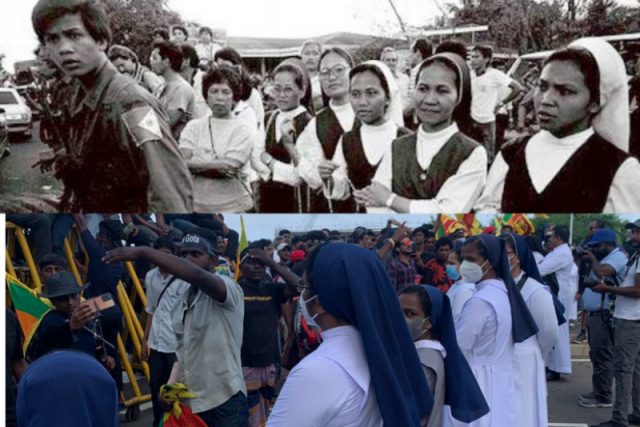
Similarities between a photo of Sri Lankan clergy forming a human barricade and scenes during the 1986 People Power Revolution in the Philippines have been observed.
Roel Raymond, editor-in-chief of Roar LK, shared an image of priests and nuns forming a “human barricade” between the protesters and police on Lotus Road in Colombo in Sri Lanka on July 9.
Priests and nuns have formed a human barricade between protestors and the police at the entrance to Lotus Road, Colombo 1. pic.twitter.com/d0BgkRcp4a
— Roel Raymond (@roelraymond) July 9, 2022
Her post immediately caught the attention of Pinoy Twitter users who drew the parallels in the replies and quote tweets.
“Reminiscent of EDSA,” historian-blogger Kristoffer Pasion commented.
“It reminds me of our own EDSA people power,” another Twitter user wrote with a yellow ribbon emoji. The yellow ribbon at that time was associated with former president Cory Aquino, the widowed wife of slain former senator Ninoy Aquino.
Another social media user shared a picture of the situation 30 years ago in Manila to juxtapose it with what is now happening in Sri Lanka.
“Very 1986 EDSA People Power Revolution in Philippines,” he wrote.
Very 1986 EDSA People Power Revolution in Philippines https://t.co/m774cBG3pV pic.twitter.com/ZtUyI3q4XV
— Rainier ❤💚💙🔴💗 #AngatBuhayNGO #OhmNanon (@iamrainierg23) July 11, 2022
The picture was taken by Pete Reyes and it featured a standoff between the military, particularly the marines, and civilians on Feb. 23, 1986, at the junction of EDSA and Ortigas Avenue.
Other photos also showed nuns clutching rosaries and staring down at the armed soldiers and the tanks.
According to veteran journalist Ed Lingao, who was at the event as a student, the nuns “knelt” and “prayed” before the government forces.
Max Soliven, who would later become the founding publisher of The Philippine STAR, said that the Philippine Marines had “demanded to pass to assault Camp Crame.”
Then-Marine Commandant Brigadier Gen. Artemio Tadiar said they were headed to the camps where forces that had broken away from the Marcos regime were holed up.
He asked a certain Gonzalo Misa Jr. to direct the crowd to proceed to EDSA between Crame and Aguinaldo if they wanted to prevent bloodshed.
The people were also given the option to “walk beside the tanks toward the back of Camp Aguinaldo,” an account noted.
“Since nobody seemed to be in charge of the crowd at that moment, Misa decided to climb the nearest tank to make his first public speech, mostly it was morale-boosting about their willingness to die right there; and he asked the crowd to pray the rosary. And people knelt before the tanks praying,” the account said.
The EDSA Revolution was a culmination of a series of public protests that happened for four days, which was a manifestation of Filipinos’ sentiments against totalitarian rule, according to the Official Gazette.
The “totalitarian rule” referred to late Ferdinand Marcos Sr’s regime that lasted for 21 years. Nine years of it were under Martial Law, which saw various human rights abuses and corruption.
Meanwhile, in Sri Lanka, demonstrations have occurred in response to their leaders’ inability to overcome a devastating economic crisis which is its worst in seven decades.
Reuters reported that the financial crisis developed after the COVID-19 pandemic hammered the country’s tourism-reliant economy and slashed remittances from overseas workers.
This was “compounded by large and growing government debt, rising oil prices and a seven-month ban on importing chemical fertilizers last year that devastated agriculture.”









